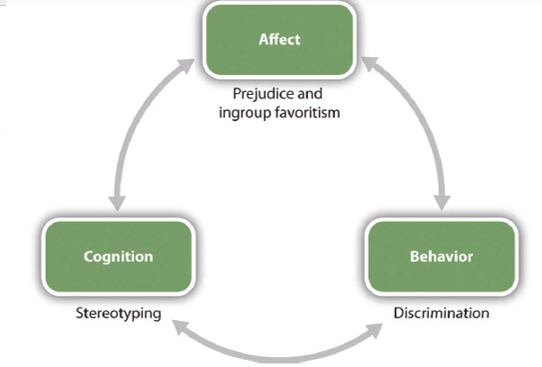Chapter 11: Stereotypes, Prejudice, & Discrimination (Social Psych)
1/26
Earn XP
Description and Tags
Name | Mastery | Learn | Test | Matching | Spaced |
|---|
No study sessions yet.
27 Terms
What is the cognitive component in our perceptions of group members and/or the positive or negative beliefs that we hold about the characteristics of social groups?
Stereotype
What is an unjustifiable negative attitude toward an outgroup or toward the members of that outgroup?
Prejudice
Our stereotypes and prejudices are problematic because they may cause ________, which is the unjustified negative behaviors toward members of outgroups based on their group membership.
Discrimination

Relationships among social groups are influenced by the ______ of social psychology.
ABCs
What occurs when we think about others in terms of their category memberships rather than on the basis of other more personal information about the individual and/or cognitively place others into social groups?
Social categorization
Prejudice and ingroup favoritism is which part of the ABCs?
Affect
Stereotyping is which part of the ABCs?
Cognition
Discrimination is which part of the ABCs?
Behavior
What is the tendency to see members of outgroups groups as similar to each other than we see members of ingroups (which is particularly strong for members of outgroups)?
Outgroup homogeneity
What is the principle of our tendency to perceive the world in ways that make it fit our existing beliefs more easily than we change our beliefs to fit the reality around us?
Assimilation
True or false? Some people are not aware of their stereotypes and prejudice and are not likely to admit these beliefs.
True
What is a Havard-developed exam that assesses an individual’s reaction time, stereotypes, and prejudice by letting them match stimuli?
Implicit Association Test (IAT)
What is the term for performance decrements that are caused by the knowledge of cultural stereotypes?
Stereotype threat
What is the tendency to respond more positively to people from our ingroups than we do to people from outgroups?
Ingroup favoritism
What is a personality dimension that characterizes people who prefer things to be simple rather than complex and who tend to hold traditional and conventional values?
Authoritarianism
Why are authoritarians ingroup-favoring?
They have a need to self-enhance and in part because they prefer simplicity and thus find it easy to think simply: “We are all good and they are less good.”
What is a personality variable that refers to the tendency to see and to accept inequality among different groups?
Social dominance orientation (SDO)
Does suppressing one’s stereotypes work at all?
Not really since these beliefs quickly pop back into mind, making it even more likely that they would immediately be used laterTr
True or false? People who are more educated express fewer stereotypes and prejudice in general.
True
What is the idea that intergroup contact will reduce prejudice known as?
The contact hypothesis
The positive effects of intergroup contact may be due in part to increases in _________.
Other-concern
What is an approach to learning in which students from different racial or ethnic groups work together, in an interdependent way, to master material?
Jigsaw classroom
What is the idea that prejudice can be reduced for people who have friends who are friends with members of the outgroup?
The extended-contact hypothesis
The attempt to reduce prejudice by creating a superordinate categorization is known as the goal of creating a ______________.
Common ingroup identity
What is the positive self-esteem that we get from our group memberships?
Social identity
What is the strong devaluation of ingroup members who threaten the positive image and identity of the ingroup known as?
The black sheep effect
What has been found to be an effective way to reduce discrimination?
Thinking of a non-stereotypical example